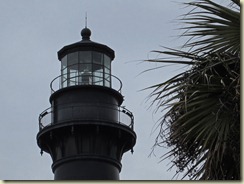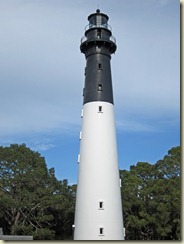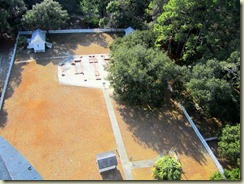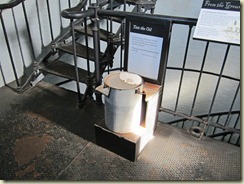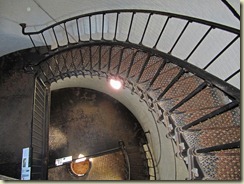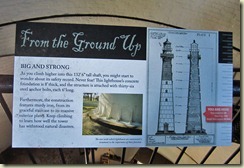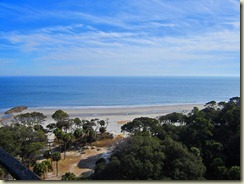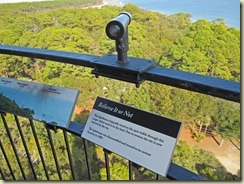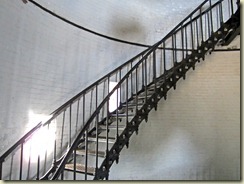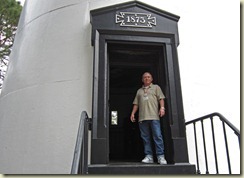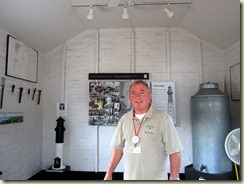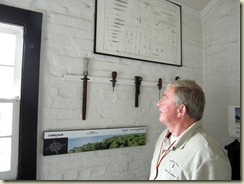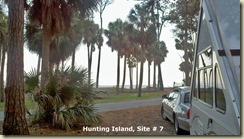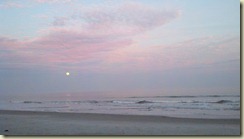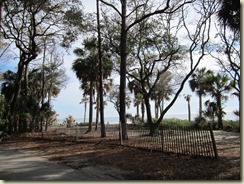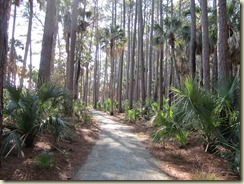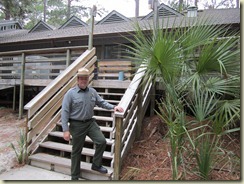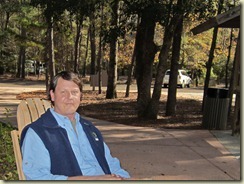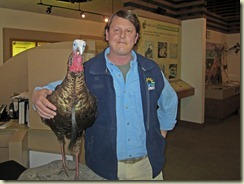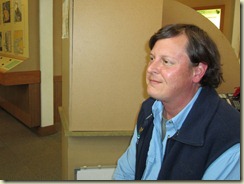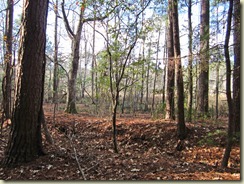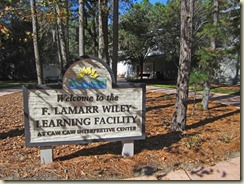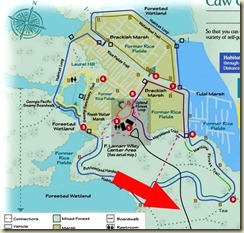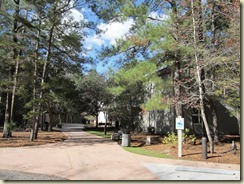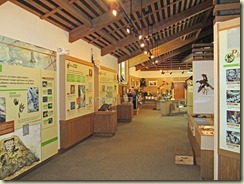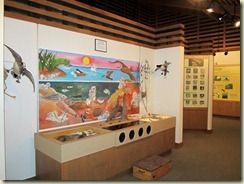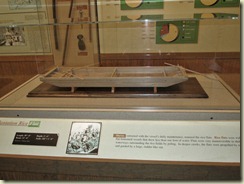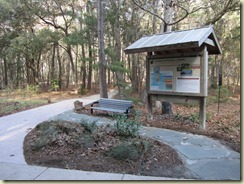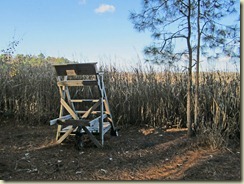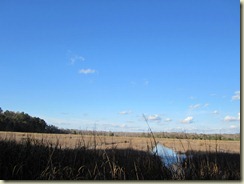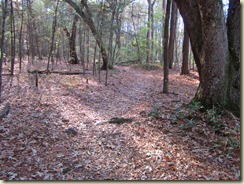Click here for the Table of Contents for this Series
I’ve never paid much attention to Hunting Island State Park’s hiking/walking/biking trails. There’s just so much else to do. Well, that was a mistake. Last visit, encouraged by Park Manager Jeff Atkins, I spent a morning walking the Hunting Island Lagoon Access Recreation Trail. That trail is remarkable. Ideal for ElderHikers with a love of nature and curiosity about things wild.
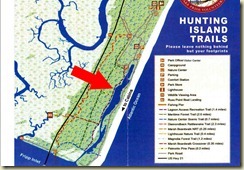 This screen capture of the Park trail map, available at the Park Office, Nature Center, and Campground Store, is a little blurry. But it’ll give you an idea of the trail’s location. Just click for a full-sized image. [And, click here to access the full map on your computer.]
This screen capture of the Park trail map, available at the Park Office, Nature Center, and Campground Store, is a little blurry. But it’ll give you an idea of the trail’s location. Just click for a full-sized image. [And, click here to access the full map on your computer.]
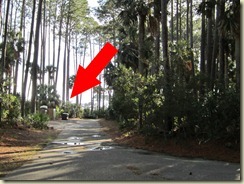 ElderHikers take note: When you drive to the parking area you’ll see a series of parking spaces on the left hand side, toward the Lagoon. Keep going. Drive on until you see the trash and comfort station facilities indicated by the red arrow in the photo above. Then you’ll be near the trail’s access point.
ElderHikers take note: When you drive to the parking area you’ll see a series of parking spaces on the left hand side, toward the Lagoon. Keep going. Drive on until you see the trash and comfort station facilities indicated by the red arrow in the photo above. Then you’ll be near the trail’s access point.
 It’s only a short walk across the road to the signs above.
It’s only a short walk across the road to the signs above.
 There you’ll have a couple of choices. Turn right for the Magnolia Trail, and left for the Lagoon Access Trail. I chose the latter. And hope to walk the Magnolia Trail next visit.
There you’ll have a couple of choices. Turn right for the Magnolia Trail, and left for the Lagoon Access Trail. I chose the latter. And hope to walk the Magnolia Trail next visit.
 This trail is beautifully planned from beginning to end. Here and there you’ll find picnic tables. Like this one. Also wooden benches thoughtfully scattered along the way.
This trail is beautifully planned from beginning to end. Here and there you’ll find picnic tables. Like this one. Also wooden benches thoughtfully scattered along the way.
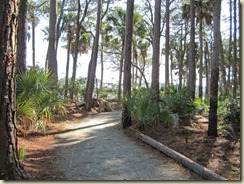 Best of all, for those of us who aren’t quite as spry as we once were, is the surface of the trail. It’s just as you see above from beginning to end. No need for folks relying on wheels to turn around after a few hundred feet.
Best of all, for those of us who aren’t quite as spry as we once were, is the surface of the trail. It’s just as you see above from beginning to end. No need for folks relying on wheels to turn around after a few hundred feet.
 Here and there was evidence of what must have been a controlled burn through this area a couple of years ago. Can you imagine assuming responsibility for one of those operations in this environment!
Here and there was evidence of what must have been a controlled burn through this area a couple of years ago. Can you imagine assuming responsibility for one of those operations in this environment!
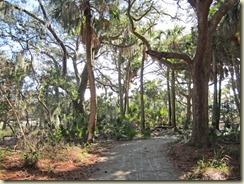 That’s a good thing. It may help to account for the beautiful natural scenery along the way. What a way to see first-hand the unusual plants and trees that cover this South Carolina barrier island.
That’s a good thing. It may help to account for the beautiful natural scenery along the way. What a way to see first-hand the unusual plants and trees that cover this South Carolina barrier island.
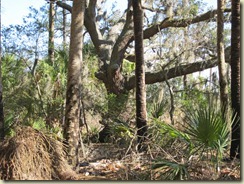 Here’s one of the many live oaks. These trees, with their unpredictable shapes, seem somehow to have individual personalities. You can see plenty of them here without leaving the trail.
Here’s one of the many live oaks. These trees, with their unpredictable shapes, seem somehow to have individual personalities. You can see plenty of them here without leaving the trail.
 Concise description of the woods seen on either side of this trail is beyond me. I won’t even try. Various types of palmettos and pines, live oaks, and other shrubs and trees that I couldn’t identify. The woods here are quite different than anything I’ve seen elsewhere in South Carolina. Including at the other ocean side State Parks.
Concise description of the woods seen on either side of this trail is beyond me. I won’t even try. Various types of palmettos and pines, live oaks, and other shrubs and trees that I couldn’t identify. The woods here are quite different than anything I’ve seen elsewhere in South Carolina. Including at the other ocean side State Parks.
 Even the forest sounds here are different. The dry palm fronds slapping against the trunks of their trees make a thwack and rustle that distinguishes this from other forest areas. Just sit on one of the trailside benches and have a listen. What an experience! I encountered only two other people along the whole trail. A young couple on mountain bikes. Great for listening. But I’ll bet it’s a lot busier here on the weekends.
Even the forest sounds here are different. The dry palm fronds slapping against the trunks of their trees make a thwack and rustle that distinguishes this from other forest areas. Just sit on one of the trailside benches and have a listen. What an experience! I encountered only two other people along the whole trail. A young couple on mountain bikes. Great for listening. But I’ll bet it’s a lot busier here on the weekends.
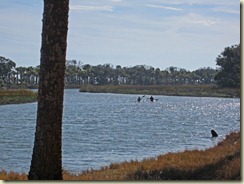 Oh, there also were two kayakers out on the lagoon. They were too far away to make noise. Fun to watch paddling along. Made me wish I had the Advanced Elements Expedition along this trip.
Oh, there also were two kayakers out on the lagoon. They were too far away to make noise. Fun to watch paddling along. Made me wish I had the Advanced Elements Expedition along this trip.
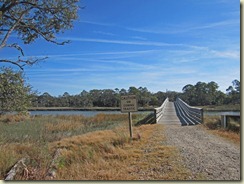 And then, far too soon, I reached the end of the trail. Walk out on the bridge for a nice view up the Lagoon if you have time. And then enjoy the walk back. Note that the wide, level, comfortably-surfaced trail extended clear to the end. Great for folks relying on wheels.
And then, far too soon, I reached the end of the trail. Walk out on the bridge for a nice view up the Lagoon if you have time. And then enjoy the walk back. Note that the wide, level, comfortably-surfaced trail extended clear to the end. Great for folks relying on wheels.
 Throughout the walk I saw little wildlife. Mostly brown pelicans swooping along the Lagoon, diving here and there to collect a fish. A few deer tracks crossed the trail down toward the southern end. But that was it. Not even many birds. I probably was making too much noise as I went along.
Throughout the walk I saw little wildlife. Mostly brown pelicans swooping along the Lagoon, diving here and there to collect a fish. A few deer tracks crossed the trail down toward the southern end. But that was it. Not even many birds. I probably was making too much noise as I went along.
 So there you have it. The best ElderHiking trail I’ve encountered in South Carolina. Hunting Island’s Lagoon Access Recreation Trail. A trail that somehow manages to combine easy access with genuinely interesting views of the forest.
So there you have it. The best ElderHiking trail I’ve encountered in South Carolina. Hunting Island’s Lagoon Access Recreation Trail. A trail that somehow manages to combine easy access with genuinely interesting views of the forest.
For my new Twitter feed, click below
Follow @CarConProjectStay tuned, now, since we have an interview with Hunting Island Park Manager, Jeff Atkins, coming up next.

